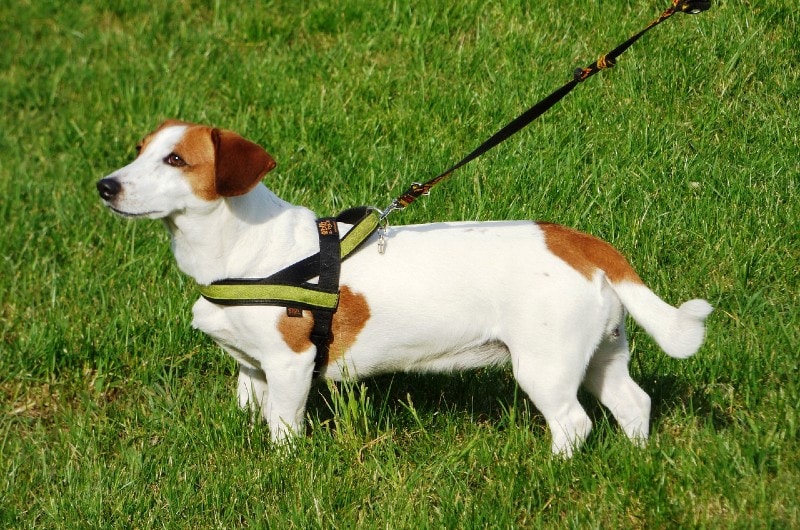VET APPROVED

The information is current and up-to-date in accordance with the latest veterinarian research.
Learn more »Click to Skip Ahead
Few things can divide the dog world as much as the discussion surrounding retractable leashes. These leashes are made to extend in a way that allows a dog far more leash length than the average dog leash. However, there are some concerns that people have about these leashes as well. It’s essential to understand both sides of the conversation, but it’s also important to note that there are appropriate and inappropriate environments for retractable leashes. Here’s what everyone should know before they use a retractable leash.

When to Use Retractable Leashes
As with anything dog-related, there are instances in which a retractable leash can be helpful to provide the dog and their walker with a relaxing experience, while in other cases it’s not appropriate or even safe. It will also greatly depend on the dog’s character.
Retractable leashes should only be used on trained calm dogs who have good recall and on walks where there is plenty of visibility of the surroundings, such as open meadows and beaches. They are not suitable for places with poor visibility such as cliff paths or areas with a high likelihood of wildlife presence. Children should never be allowed to use a retractable leash. Dogs that are reactive, are not leash- or recall-trained, hunting dogs and fearful dogs should not be walked on a retractable leash.
Pros of Retractable Leashes

- Improved Independence – Using a retractable leash gives your dog more independence on your walks. It allows them more leash length and the ability to walk at their own pace. For some dogs, this can provide a feeling of independence and improve confidence, while keeping them at a safe distance.
- Increased Enrichment Opportunities – Enrichment can be provided to your dog in many ways, and one way is by going for more interesting walks. A retractable leash can increase the opportunities for enrichment for your dog by allowing more access to more things. Some dogs enjoy going for a “sniffari,” or a walk focused on sniffing and scent work over exercise, and a retractable leash can allow your dog to access more areas to sniff.
Cons of Retractable Leashes

- Training Issues – A retractable leash should not be used for a dog that is not thoroughly recall- and leash-trained since there is always a degree of tension on this type of leash. Retractable leashes are not a replacement for leash training or recall training. Some people make the mistake of using a retractable leash in place of appropriate training techniques, but this leads to more problems.
- Lack of Control – When your dog is on a retractable leash, they can access more places more quickly than you may anticipate. This means that your dog potentially has increased access to dangerous places or situations. If your dog tends to pick up food or objects on walks, then a retractable leash can increase their access to these things, before you have a chance to react. It can also increase the risk of your dog encountering other animals, dangerous plants, and running out on the road, with little leash left for you to pull them back. The further your dog is away from you, the less control you have over what they do, and it only takes a second for them to get into trouble.
- Injuries to Dogs – There are a considerable number of ways your dog can be injured while using a retractable leash. Most of these injuries are related to picking things up on walks, getting into fights with other animals, or stepping out onto the road, but another risk of retractable leashes comes from dogs that tend to bolt. If your dog bolts and suddenly hits the end of the leash, it can lead to neck, throat, shoulder and back injuries for the dog, and for you as well. There is also a risk of your dog becoming tangled in the leash, leading to cuts and injuries, or tangling another dog up, which may lead to a fight. A leash can get stuck around branches or rocks, or may snap, causing your dog to run off.
- Injuries to People – Having your dog on a retractable leash isn’t just risky for your dog; it’s also a risk for you. Retractable leashes are made with thin, strong cords that can lead to burns and cuts if they rub against the skin. It’s not uncommon for people to become injured when a dog wraps the leash around them, especially if the dog is excited or fearful and attempting to get away. There is also a risk of shoulder and neck injuries for someone holding a retractable leash when their dog bolts and hits the end of it. Grabbing the leash with your fingers can lead to severe burns and cuts, or even finger amputations if the leash gets wrapped around a finger.
Conclusion
While retractable leashes have some benefits for certain canine temperament and walking environments, they generally carry more risks. They are typically misused with dogs that have not been properly trained to walk on a retractable leash. The cons of retractable leashes outweigh the pros in most situations, but there are some times when they are appropriate in calm and well-trained dogs. It’s essential to consider the benefits and risks of using a retractable leash, not only before getting one but every time you pick it up to use it.
Featured Image Credit: Tomasz_Mikolajczyk, Pixabay












